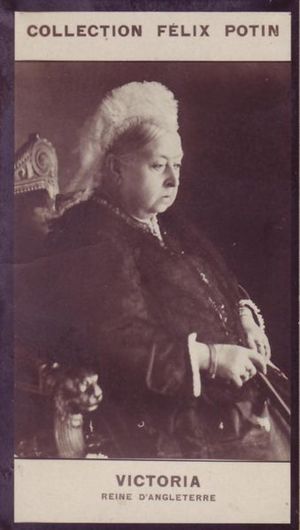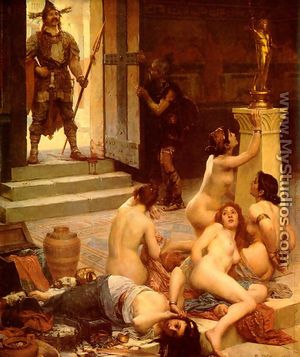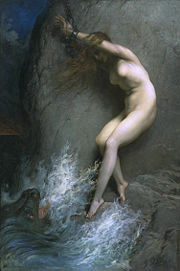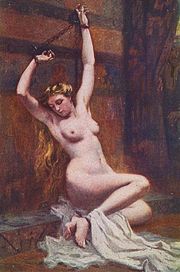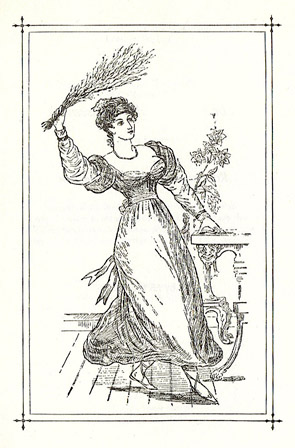Victorian era
| Periods in English history | |
|---|---|
| Roman Britain | Circa 43–410 |
| Anglo-Saxon | Circa 500–1066 |
| Norman | 1066–1154 |
| Plantagenet | 1154–1485 |
| Tudor | 1485–1603 |
| Elizabethan | 1558–1603 |
| Stuart | 1603–1714 |
| Jacobean | 1603–1625 |
| Carolean | 1625–1649 |
| (Interregnum) | 1649–1660 |
| Restoration | 1660–1688 |
| Georgian | 1714–1830 |
| Regency | 1830–1837 |
| Victorian | 1837–1901 |
| Edwardian | 1901–1914 |
| First World War | 1914–1918 |
| Interwar | 1918–1939 |
| Second World War | 1939–1945 |
| Postwar | 1945–1981 |
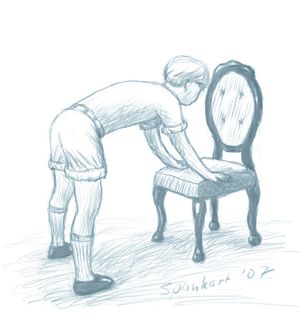
The Victorian era [1] is the time period of England's Queen Victoria's reign, 1837-1901, i.e. the mid and late 19th century. It is considered the height of the British industrial revolution and the apex of the British Empire.
The term Victorian has acquired a range of connotations, including that of a particularly strict set of moral standards, which are often applied hypocritically. Other connotations are prudery, sexual repression (often leading to unhealthy or violent acts of sublimation), low tolerance of crime, contempt for the lower classes, and a strong social ethic, often based around a rigid interpretation of Christian values.
However, hidden behind the carefully maintained facade of Victorian morality and self-restraint was a strong surge of sexual experimentation that encompassed a wide range of practices. In particular, the Victorians had a fascination with corporal punishment and erotic sadomasochism in art and literature which ranged from graphic pornography to pseudo-scholarly tomes on the history of flagellation.
This obsession became known as The English Vice and led to the creation of private whipping clubs and London's flagellatory brothels which featured elegant whipping and birching facilities for sadists as well as masochists. (The famous S&M brothel of Theresa Berkley, dating back to the 1820s, was one such club known for catering to the aristocrasy.)
The sex-and-birching novel "Frank" and I (1902) describes brothels in London and Paris that featured tableaux vivants where prostitutes would dress up in costumes and perform whipping scenarios from other times and places for the amusement of their clients.
It was an era when parents firmly believed in the maxim, "Spare the rod and spoil the child." Another popular saying of the time was, "A woman, a dog, and a walnut tree, the more you beat them, the better they'll be." Domestic violence was widespread, but contrary to common belief, there was no "Rule of Thumb" which made it legal for a man to spank or beat his wife with a stick provided it was no thicker than his thumb.
The Victorian era was preceded by the Regency Period (1811 - 1820) and succeeded by the Edwardian era (1901 - 1910).
Art in the Victorian era
Queen Victoria and Prince Albert held firmly to the naive and virtuous belief that all art should educate and uplift its viewers. And they rewarded artists who produced works of meticulous naturalism that depicted English life in an idealized, often sentimental, manner. Scenes from contemporary life, anecdotes of home and hearth, moral preachments, and narrative-packed literary and historical compostions, many on an epic scale, were the order of the day.
Overt sensuality, common in French art at the time, was frowned upon. However, several academic painters such as Sir Lawrence Alma-Tadema and Frederick Lord Leighton gained popularity by portraying nude and seminude figures in exotic scenes from mythology and classical antiquity ' Greek and Egyptian slaves, Roman baths, Turkish harems, etc. The beautiful damsel in distress (bound in various states of undress), including religious martrys and romantic figures from history and literature was another frequently exploited theme. For example, the myth of Andromeda, chained naked to a rock as a sacrifice to a sea monster, was a favorite subject among painters who jumped at the chance to eroticize the bondage and noble suffering of the voluptuous nude figure.
This rigid view of art began to crumble in the last decade of the 19th Century as the new Aesthetic movement gained in popularity. James McNeill Whistler, an American expatriate living in London, along with the Pre-Raphaelites, Aubrey Beardsley, Oscar Wilde, the French Impressionists, and others ushered in a new spirit of "Art for Art's Sake" modernism that shunned anectodal and moralizing subjects in favor of painting devoted to the direct perception of beauty as an end in itself.
Victorian erotic literature
Art in the Victorian era was strong in academic realism (the style of William-Adolphe Bouguereau et al.). A big web gallery devoted to this style of art is the Art Renewal Center. Among the best known works of fiction that portray life in the Victorian era are the novels of Thomas Hardy and Charles Dickens (1812-1870), such as Oliver Twist and David Copperfield. Several of Dickens' books contain references to the corporal punishment of children, which he was against.
There were also a great many underground novels devoted to flagellation erotica by "Anonymous" or penned under pseudonyms. These books were mainly written by hacks, however, some contained borrowings from established literary models, such as Dickens. Some of these novels were published in England, while many more were printed in Paris where the censorship laws were less stringent. To avoid legal prosecution, these books were discreetly sold through private subscription. The tone of most of these books ' including those disguised as scholarly historical studies ' reveal a secret Victorian obsession with sexual excitement associated with giving or receiving severe whippings, birchings, and canings, as well as various forms of dominance and humiliation.
The social stratification within these stories is also revealing. Most were written (or rewritten) to appeal to the educated ranks of the upper middle class. The heroes and heroines are all taken from the wealthy, aristocratic realm of society, while the well-punished victims are generally servants and other members of the lower classes. This is because most erotic books at this time were lavishly produced in limited editions for discriminating clients who could afford them. Pornography was a vice of the well-to-do, not the general public.
Some of the anonymous authors of these stories amused themselves by including elements of social satire. In particular, The Confessions of Georgina (1893) and Birch in the Boudoir (1905) take delight in mocking the hypocrisy and perversity of Victorian morality. Other tales such as The Convent School, or Early Experiences of A Young Flagellant (1876) take aim at religious institutions. And countless novels exposed cruel and perverse practices at public and private schools and prisons. The post-Victorian Esclaves Modernes (Modern Slaves) from 1910 by Jean de Virgans is quite unique. It lampoons racism in an outrageous tale of power exchange with aristocratic white women whipped and abused by African natives.
Following in the wake of the popular 1870 Austrian novel Venus in Furs, some authors also began to explore the subject of male sexual slavery or femdom as well as pony play, enema punishment, and other exotic torments. This includes tales of men forced into cross-dressing petticoat punishment, and dressage training (humans turned into cart-pulling pony slaves).
Selected works
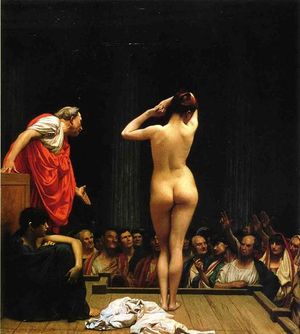
- The Romance of Chastisement (1866) by St. George H. Stock (William Dugdale: London). Reprinted by Charles Carrington in 1902 as The Magnetism of the Rod or the Revelations of Miss Darcy.
- Personal Recollections of the Use of the Rod (1868) by Margaret Anson, pseudonym of British author James Glass Bertram (John Camden Hotten: York). Reprinted by Blue Moon Books in 2000; also published as The Merry Order of St. Bridget. Under the nom de plume Rev. William Cooper, Bertram also wrote the fictionalized Flagellation and the Flagellants. A History of the Rod (1869), a best-seller for Hotten.
- Library Illustrative of Social Progress (1872) by Anonymous (publisher: J.C. Hotten).
- The Convent School, or Early Experiences of A Young Flagellant (1876) by Rosa Coote [pseud.], (William Dugdale: London).
- The Pleasures of Cruelty, being a sequel to the reading of Justine et Juliette by the Marquis de Sade (ca. 1880) by Anonymous. A extract entitled The Sultan's Reverie was first published in 1880 in the erotic magazine The Pearl.
- The Whippingham Papers (ca. 1888) by Anonymous, with poetry ascribed to Algernon Charles Swinburne, edited by St. George H. Stock.-A collection of Victorian stories and verse about erotic flagellation.
- First Training (ca. 1890) by Anonymous. The sexual and disciplinary coming-of-age of a young English lady and her brother, sister, and relatives.
- The Yellow Room (1891) by Anonymous (generally attributed to M. Le Compte Du Bouleau, aka Stanislas Matthew de Rhodes).-Novella about an eighteen-year-old girl educated and disciplined by her stern aunt and uncle. Reprinted along with another Victorian novella, Letters to a Lady Friend, in Whipped into Shape: Two Classic Erotic Novellas by Renaissance E Books Inc. (2004).
- The Confessions of Georgina (1893) by Julian Robinson (aka Stanislas Matthew de Rhodès)-a tale of bondage and domination that satirizes the hypocrisy of Victorian morality.
- Gynecocracy. A narrative of the adventures and psychological experiences of Julian Robinson under petticoat rule. (1893) by anonymous (attributed to Stanislas Matthew de Rhodes), published in England by Leonard Smithers.
- The Lustful Turk, or Lascivious Scenes from a Harum by Anonymous. (First published in 1828, but not widely known until it was reprinted by William Dugdale in 1893). An erotic novel of sex and sadism that consists largely of a series of letters written by its heroine, Emily Barlow, after being abducted by Moorish pirates and held prisoner in an Algerian harem. The 1968 sexploitation film The Lustful Turk is based on the novel.
- Beatrice (1895) by Anonymous. Punishment erotica published by Charles Carrington.
- A Full and True Account of the Wonderful Mission of Earl Lavender (1895) by John Davidson (London: Ward & Downey). Private whipping clubs and other flagellatory adventures from poet and humorist John Davidson.
- Tales of Fun and Flagellation (1896) by Lady Gay Spanker [pseud.].-A diverse collection of anecdotes and stories.
- The Petticoat Dominant, or Woman's Revenge-The Autobiography of a Young Nobleman (1898) by Julian Robinson (aka Stanislas Matthew de Rhodès); an early classic of male-submissive pinafore eroticism.
- Lashed into Lust: The Caprice of a Flagellator (1899) by Anonymous.-French novel reprinted in 1908 with "James Lovebirch" as author. Reprinted in 2000 by Blue Moon Books (New York).
- Memoirs of Private Flagellation (1899) by Anonymous (Paris, Librairie des Bibliophiles Français et Étrangers).
- The Memoirs of Dolly Morton (1899) by Anonymous (generally attributed to Jean de Villiot, aka Hugues Rebell). Edited and published in London and Paris by Charles Carrington.
- Nell in Bridewell by Wilhelm Reinhard (original title: Lenchen im Zuchthause), first English translation published in 1900 by The Society of British Bibliophiles (Charles Carrington) in Paris. This influential book tells the story of a young woman who experienced the horrors and indignities of a 19th century House of Correction in Germany.
- Curious Cases of Flagellation in France (1901) by Augustin Cabanès (London, privately printed for the subscribers to Dr. Cabanès Bypaths of History).
Parenting and education in the Victorian era
Parenting and education in the Victorian era was very strict by today's standards and infamous for its use of corporal punishment, along with other punishment methods that were designed to maximize the humiliation and shame of the juvenile delinquent.
It included methods such as caning, birching, strapping, tawsing, switching, slippering, spanking, and corner time. Other, more 'exotic' forms of punishment that were allegedly (probably only occasionally) used in the Victorian era included punishment enemas and figging.
See also
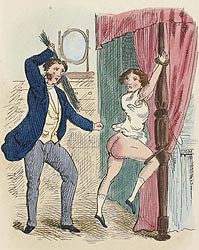
Links
- More information is available at [ Wikipedia:Victorian morality ]
References
- ↑ SM-201 0713
